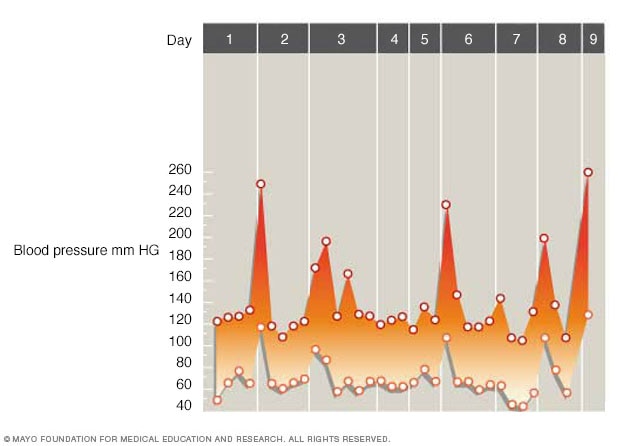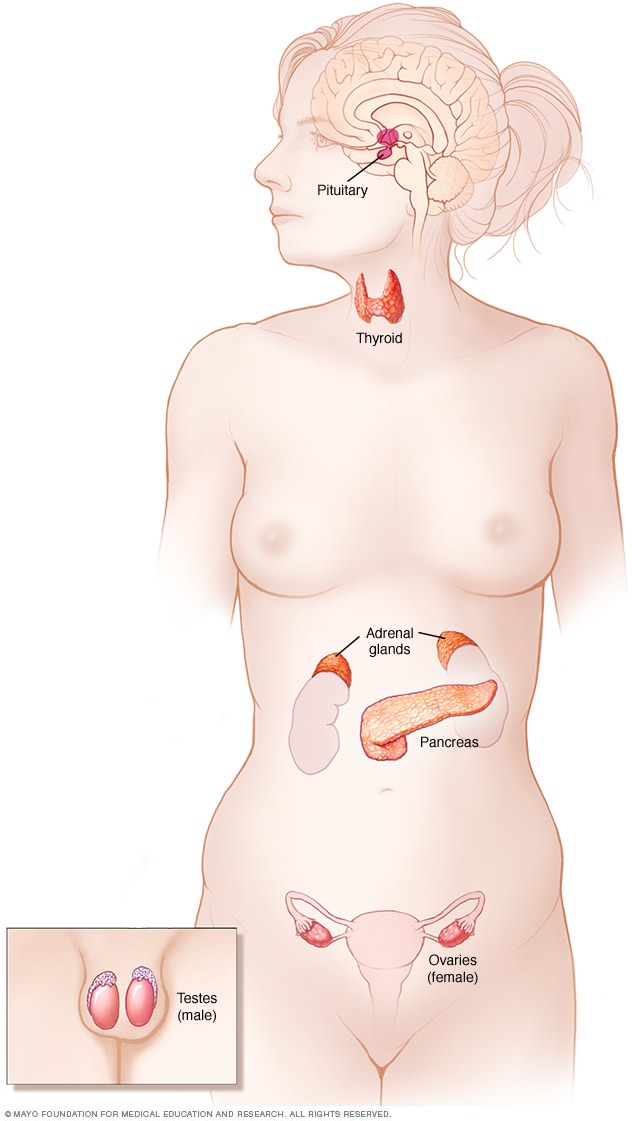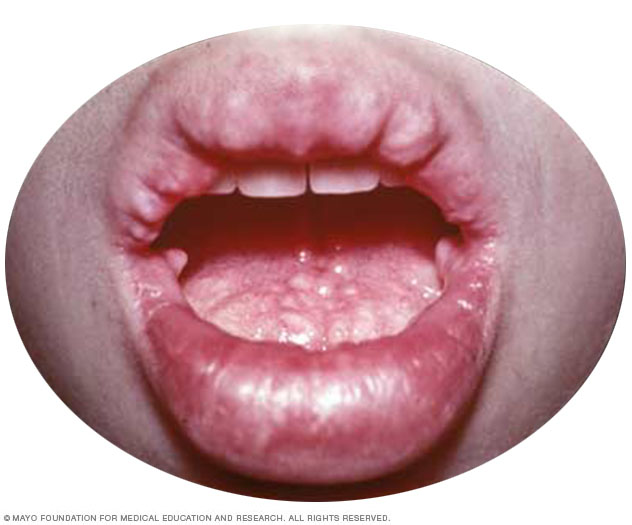Pheochromocytoma
Updated: 2024-03-01
Overview

Pheochromocytoma and irregular blood pressure
A pheochromocytoma can cause large changes in blood pressure. When that happens, it's called a spell. Blood pressure may return to a healthy range between spells. That can make it harder to diagnose a pheochromocytoma. The graph shows a nine-day period of short, irregular bursts in blood pressure due to a pheochromocytoma. The lower points show the bottom number of the reading, called diastolic pressure. The higher points show the top number of the reading, called systolic pressure. For example, the first burst in blood pressure is seen on day two with a reading of 250/110 millimeters of mercury.
A pheochromocytoma (fee-o-kroe-moe-sy-TOE-muh) is a rare tumor that grows in an adrenal gland. Most often, the tumor is not cancer. When a tumor isn't cancer, it's called benign.
You have two adrenal glands — one at the top of each kidney. The adrenal glands make hormones that help control key processes in the body, such as blood pressure. Usually, a pheochromocytoma forms in only one adrenal gland. But tumors can grow in both adrenal glands.
With a pheochromocytoma, the tumor releases hormones that can cause various symptoms. They include high blood pressure, headache, sweating and symptoms of a panic attack. If a pheochromocytoma isn't treated, serious or life-threatening damage to other body systems can happen.
Surgery to remove a pheochromocytoma often returns blood pressure to a healthy range.
Symptoms
A pheochromocytoma often causes the following symptoms:
- High blood pressure.
- Headache.
- Heavy sweating.
- Rapid heartbeat.
Some people with pheochromocytomas also have symptoms such as:
- Nervous shaking.
- Skin that turns a lighter color, also called pallor.
- Shortness of breath.
- Panic attack-type symptoms, which can include sudden intense fear.
- Anxiety or a sense of doom.
- Vision problems.
- Constipation.
- Weight loss.
Some people with pheochromocytomas have no symptoms. They don't realize they have the tumor until an imaging test happens to find it.
Symptom spells
Most often, the symptoms of pheochromocytoma come and go. When they start suddenly and keep coming back, they're known as spells or attacks. These spells may or may not have a trigger that can be found.
Certain activities or conditions can lead to a spell, such as:
- Physical hard work.
- Anxiety or stress.
- Changes in body position, such as bending over, or going from sitting or lying down to standing.
- Labor and delivery.
- Surgery and a medicine that causes you to be in a sleep-like state during surgery, called an anesthetic.
Foods high in tyramine, a substance that affects blood pressure, also can trigger spells. Tyramine is common in foods that are fermented, aged, pickled, cured, overripe or spoiled. These foods include:
- Some cheeses.
- Some beers and wines.
- Soybeans or products made with soy.
- Chocolate.
- Dried or smoked meats.
Certain medicines and drugs that can trigger spells include:
- Depression medicines called tricyclic antidepressants. Some examples of tricyclic antidepressants are amitriptyline and desipramine (Norpramin).
- Depression medicines called monoamine oxidase inhibitors (MAOIs), such as phenelzine (Nardil), tranylcypromine (Parnate) and isocarboxazid (Marplan). The risk of spells is even higher if these medicines are taken with foods or drinks high in tyramine.
- Stimulants such as caffeine, amphetamines or cocaine.
When to see a doctor
High blood pressure is one of the main symptoms of a pheochromocytoma. But most people who have high blood pressure don't have an adrenal tumor. Talk to your healthcare professional if any of these factors apply to you:
- Spells of symptoms linked with pheochromocytoma, such as headaches, sweating and a fast, pounding heartbeat.
- Trouble controlling high blood pressure with your current treatment.
- High blood pressure that starts before the age of 20.
- Recurring large rises in blood pressure.
- A family history of pheochromocytoma.
- A family history of a related genetic condition. These include multiple endocrine neoplasia, type 2 (MEN 2), von Hippel-Lindau disease, inherited paraganglioma syndromes and neurofibromatosis 1.
Causes

Endocrine system
The endocrine system is made up of glands and organs that make hormones. The endocrine system includes the pituitary gland, thyroid gland, parathyroid glands, adrenal glands, pancreas, ovaries and testicles.
Researchers don't know exactly what causes a pheochromocytoma. The tumor forms in cells called chromaffin cells. These cells are located in the center of an adrenal gland. They release certain hormones, mainly adrenaline and noradrenaline. These hormones help control many body functions, such as heart rate, blood pressure and blood sugar.
Adrenaline and noradrenaline trigger the body's fight-or-flight response. That response happens when the body thinks there is a threat. The hormones cause blood pressure to rise and the heart to beat faster. They also prepare other body systems so you can react quickly. A pheochromocytoma causes more of these hormones to be released. And it causes them to be released when you're not in a threatening situation.
Most of the chromaffin cells are in the adrenal glands. But small clusters of these cells also are in the heart, head, neck, bladder, stomach area and along the spine. Chromaffin cell tumors located outside of the adrenal glands are called paragangliomas. They may cause the same effects on the body as a pheochromocytoma.
Risk factors

Multiple endocrine neoplasia, type 2B (MEN 2B)
People with MEN 2B have tumors of nerves in the lips, mouth, eyes and digestive tract. They also may have a tumor on the adrenal gland, called pheochromocytoma, and medullary thyroid cancer.
A person's age and certain medical conditions can raise the risk of a pheochromocytoma.
Most pheochromocytomas are found in people between the ages of 20 and 50. But the tumor can form at any age.
People who have certain rare genetic conditions have a higher risk of pheochromocytomas. The tumors can be benign, meaning they are not cancer. Or they can be malignant, meaning they are cancer. Often, benign tumors related to these genetic conditions form in both adrenal glands. Genetic conditions linked with pheochromocytoma include:
- Multiple endocrine neoplasia, type 2 (MEN 2). This condition can cause tumors in more than one part of the body's hormone-making system, called the endocrine system. There are two types of MEN 2 — type 2A and type 2B. Both can involve pheochromocytomas. Other tumors linked with this condition can appear in other parts of the body. These body parts include the thyroid, parathyroid glands, lips, mouth and digestive system.
- Von Hippel-Lindau disease. This condition can cause tumors in many parts of the body. Possible sites include the brain and spinal cord, endocrine system, pancreas and kidneys.
- Neurofibromatosis 1. This condition causes tumors in the skin called neurofibromas. It also can cause tumors of the nerve at the back of the eye that connects to the brain, called the optic nerve.
- Hereditary paraganglioma syndromes. These conditions are passed down in families. They can result in pheochromocytomas or paragangliomas.
Complications
A pheochromocytoma can lead to other health problems. The high blood pressure linked with a pheochromocytoma can damage organs, especially tissues of the heart and blood vessel system, brain and kidneys. This damage can cause dangerous conditions, including:
- Heart disease.
- Stroke.
- Kidney failure.
- Vision loss.
Cancerous tumors
Rarely, a pheochromocytoma is cancerous, and the cancer cells spread to other parts of the body. Cancer cells from a pheochromocytoma or paraganglioma most often travel to the lymph system, bones, liver or lungs.
Diagnosis
To find out if you have a pheochromocytoma, your healthcare professional likely will order various tests.
Lab tests
These tests measure levels of the hormones adrenaline and noradrenaline, and substances that can come from those hormones called metanephrines. Raised levels of metanephrines are more common when a person has a pheochromocytoma. Metanephrine levels are less likely to be high when a person has symptoms due to something other than pheochromocytoma.
- 24-hour urine test. In this test, you collect a urine sample every time you urinate over 24 hours. Ask for written directions about how to store, label and return the samples.
- Blood test. A healthcare professional takes a sample of blood to be tested in the lab.
For both types of tests, ask your healthcare professional if you need to do anything to prepare. For example, you may be asked not to eat for a certain amount of time before the test. This is called fasting. Or you may be asked to skip taking a certain medicine. Don't skip a medicine dose unless a member of your healthcare team tells you to and gives you directions.
Imaging tests
If the lab test results find signs of a pheochromocytoma, imaging tests are needed. Your healthcare professional likely will order one or more of these tests to find out if you have a tumor. These tests may include:
- CT scan, which combines a series of X-ray images taken from different angles around your body.
- MRI, which uses radio waves and a magnetic field to make detailed images.
- M-iodobenzylguanidine (MIBG) imaging, a scan that can detect tiny amounts of an injected radioactive compound. The compound is taken up by pheochromocytomas.
- Positron emission tomography (PET), a scan that also can detect radioactive compounds taken up by a tumor.
A tumor in an adrenal gland might be found during imaging studies done for other reasons. If that happens, healthcare professionals often will order more tests to find out if the tumor needs to be treated.
Genetic testing
Your healthcare professional might recommend genetic tests to see whether a pheochromocytoma is related to a genetic condition. Information about possible genetic factors can be important for many reasons:
- Some genetic conditions can cause more than one medical problem. So, test results may suggest the need to screen for other medical conditions.
- Some genetic conditions are more likely to happen again or be cancer. So, your test results may affect treatment decisions or long-term plans to track your health.
- Results from tests may suggest that other family members should be screened for pheochromocytoma or related conditions.
Genetic counseling can help you understand the results of your genetic testing. It also can help your family manage any mental health issues tied to the stress of genetic testing.
Treatment
The main treatment for a pheochromocytoma is surgery to remove the tumor. Before you have surgery, your healthcare professional likely will prescribe certain blood pressure medicines. These medicines block high-adrenaline hormones to lower the risk of dangerously high blood pressure during surgery.
Preparing before surgery
You'll likely take medicines for 7 to 14 days before surgery to help lower blood pressure. These medicines will either replace or be added to other blood pressure medicines you take. You also may be told to eat a high-sodium diet.
Medicines such as alpha blockers, beta blockers and calcium channel blockers keep smaller veins and arteries open and relaxed. This improves blood flow and lowers blood pressure. Some of these medicines also may cause the heart to beat more slowly and with less force. This can lower blood pressure more.
Because these medicines widen the blood vessels, they cause the amount of fluid within the blood vessels to be low. This can cause dangerous drops in blood pressure when you stand up. A high-sodium diet can draw more fluid inside the blood vessels. This helps prevent low blood pressure during and after surgery.
Surgery
Most often, a surgeon makes a few small cuts called incisions in the stomach area. Wandlike devices equipped with video cameras and small tools are placed through the cuts to do the surgery. This is called laparoscopic surgery. Some surgeons do the procedure with robotic technology. They sit at a nearby console and control robotic arms, which hold a camera and surgery tools. If the tumor is very large, surgery that involves a larger incision and opening the abdominal cavity may be needed.
Often, the surgeon removes the entire adrenal gland that has the pheochromocytoma. But the surgeon might remove only the tumor, leaving some healthy adrenal gland tissue. This may be done when the other adrenal gland also has been removed. Or it may be done when there are tumors in both adrenal glands.
If a tumor is cancer, and the cancer has spread to other organs, surgery may not be able to remove all of the cancer tissue. Removing as much of the tumor as possible along with medical therapy might ease pheochromocytoma symptoms. It also makes blood pressure easier to control.
After surgery
If one healthy adrenal gland remains, it can carry out the functions usually done by two glands. Blood pressure usually returns to a healthy range after surgery. You'll need regular checkups with your healthcare professional for the rest of your life. These appointments help track your health, find other health concerns and check to see if the tumor has come back. If both adrenal glands are removed, you’ll need to take steroid medicines for the rest of your life. These medicines replace certain hormones that the adrenal glands make.
Cancer treatments
Very few pheochromocytomas are cancer. Because of this, research about the best treatments is limited. Treatments for cancerous tumors and cancer that has spread in the body, related to a pheochromocytoma, may include:
- Targeted therapies. These use a medicine combined with a radioactive substance that seeks out cancer cells and kills them.
- Chemotherapy. This treatment uses powerful drugs that kill fast-growing cancer cells. It may help ease symptoms in people with pheochromocytomas whose cancer has spread.
- Radiation therapy. This treatment uses beams of intense energy to kill cancer cells. It may relieve symptoms of tumors that have spread to the bone and cause pain.
- Ablation. This treatment can destroy cancer tumors with freezing temperatures, high-energy radio waves or ethanol alcohol.
Preparing for an appointment
You're likely to start by seeing your primary healthcare professional. Then you might be referred to a specialist in hormonal conditions called an endocrinologist.
Here's some information to help you get ready for your appointment. Take a family member or friend along if you can. This person can help you remember the information that your care team gives you.
What you can do
When you make the appointment, ask if there's anything you need to do in advance. For example, you may be asked not to eat for a certain amount of time before the appointment. This is called fasting. Or you may need to make medicine changes before you have a specific test.
Before your appointment, make a list of:
- Your symptoms, including any changes from how you typically feel, when they began and how long they last.
- Key personal information, including major stresses, recent life changes and family medical history.
- All medicines, vitamins, herbs and other supplements you take, including doses.
- Questions to ask your healthcare professional.
Questions to ask your healthcare professional may include:
- What's likely causing my symptoms?
- Other than the most likely cause, what are other possible causes for my symptoms?
- What tests do I need?
- Is my condition likely short term or ongoing?
- What treatment do you recommend?
- Are there other treatment options aside from the main one you've suggested?
- I have other health conditions. How can I best manage them together?
- Are there restrictions I need to follow?
- Should I see a specialist?
- Are there brochures or other printed material I can have? What websites do you recommend?
Feel free to ask other questions during your appointment.
What to expect from your doctor
Your healthcare professional is likely to ask you questions, including:
- Have your symptoms been constant, or do they come and go?
- Does anything seem to make your symptoms better?
- What, if anything, appears to trigger your symptoms or make them worse?
- Do you have any other medical conditions? If so, what treatment are you getting?
- Do you have a family history of adrenal tumors or other endocrine tumors?